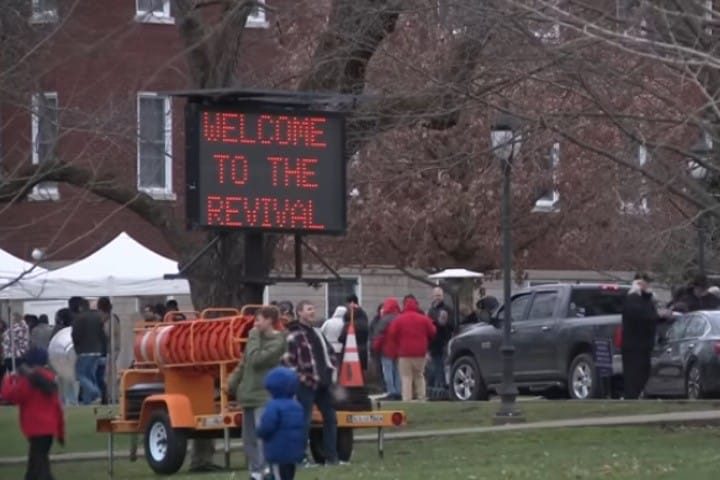
As the revival that began in Hughes Auditorium on the campus of Asbury University on Wednesday, February 8, continues into its 12th day, some observers are asking if this is truly a revival — a moving of the Holy Spirit that transforms lives permanently in this world and eternally in the next.
On the surface it has all the appearances of a genuine revival, emanating from the ground up. There is no evidence, according to skeptics attending the continuing meeting together of thousands in Hughes and other locations in Wilmore, Kentucky, of any deliberate manipulation, no observable planning behind the scenes that generated the movement.
As The New American reported last week, Thomas McCall, a professor of theology at Asbury, was initially skeptical: “I am weary of hype and very wary of manipulation.… I do not want anything to do with that.”
But, after attending the gathering every day from its beginning, he wrote:
Truth be told, this is nothing like that. There is no pressure or hype. There is no manipulation. There is no high-pitched emotional fervor.
There is no doubt about one fact: thousands have descended on Wilmore (population, 6,000) to partake of the event. They have driven hundreds of miles, have flown in from every state in the union, and many have come from as far away as the Philippines, Finland, and the Netherlands. There are similar happenings on college campuses across the land, surprising many at the ripple effect emanating from Asbury.
Drones have recorded miles of cars waiting to get into town and hundreds of people lined up outside Hughes and other local venues waiting for someone to leave so they can enter.
One observer tweeted:
Over 20,000 people came to Asbury last night [Friday, Feb. 17] with 5 overflowing buildings and a grass lawn filled. There is a 2.5 mile backup of cars going into Wilmore.
Hashtag #asburyrevival has generated more than 70 million views on TikTok.
Asbury President Kevin Brown was forced to announce that, effective today, Hughes Auditorium will be closed to the public, and will be open only to students, staff, and faculty until Thursday:
Our town’s institutions … our town’s infrastructure … is just not [able] to absorb … the influx of the blessed guests that have come to Wilmore.
As said, on the surface this looks like the real deal: an outpouring of the Holy Spirit onto a hungry and seeking generation — mostly Generation Z — in a world turned upside-down by the machinations of the evil one.
Student body president Alison Perfater appeared on Tucker Carlson Tonight, and expressed the same bafflement over the event as many others have:
For seemingly no reason at first on Wednesday, February 8, it didn’t end.…
What’s been happening here since Wednesday is there’s a young army of believers who are rising to claim Christianity — the faith — as their own, as a young generation … [they] cannot get enough.
One skeptic, Samuel Sey, writing for the Christian Post, called on his own personal experience about people “getting saved” at “revivals” such as this one: “Within weeks … the vast majority … who professed faith in Christ had returned to unrepentant sin.”
It’s that lack of repentance that was missing in so many other revivals that Sey had attended in his past:
If we actually cared about simply preaching that God became a man, lived a sinless and righteous life, suffered on the cross, received our sins, gave us his righteousness, died to satisfy the wrath of God, and rose again for our justification — so that God would declare us righteous by faith: there would probably be more repentance that would lead to a real revival.
It’s called “easy believism” — the view that one only need believe intellectually that Christ died on the cross in order to be saved. It is a brain decision, and not a heart commitment. There is, according to the Christian website GotQuestions, “no corresponding need … for a committed life of Christian discipleship as proof of salvation.… [People believing this] believe they’re saved [just] because they prayed a prayer — with no real conviction of sin and no real faith in Christ.”
Timothy Tennent, president of Asbury Theological Seminary (just across the street from the Asbury University campus), provides an answer to Sey’s skepticism. He has attended the gathering at Hughes Auditorium every day since its genesis. He wrote:
There comes a point when the people of God become tired of causal [sic] prayers and move to that point of desperation which opens us up in fresh ways to God’s surprising work. That is what I have experienced most over the past week in my own life.…
Despite the endless coverage in social media and the regular media which is calling this a revival, I think it is wise to see this, at the current phase, as an awakening.
Only if we see lasting transformation which shakes the comfortable foundations of the church and truly brings us all to a new and deeper place can we look back, in hindsight and say “yes, this has been a revival.”
It will prove to have been a revival only with the passage of time:
We must keep our hearts and eyes fixed on Jesus and ask for Him to complete the work He has begun so that, over time, there is a lasting transformation in the lives of those who are being touched by God.…
What we are doggedly seeking is not lasting memories, but transformed lives long after the lights go out in Hughes Auditorium or Estes Chapel or all other places which are experiencing this work of grace.
Related article:
Surprise Revival at Asbury University Spreading Across the Land



